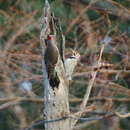Brief Summary
provided by EOL authors
The Northern Flicker (Colaptes auratus) is an extremely widely distributed woodpecker in North and Middle America. As the species boundaries are currently defined, the range of this species includes most of Canada south to north-central Nicaragua. Formerly, the Northern Flicker was treated as two separate species, the Yellow-shafted Flicker (C. auratus) to the east and north and the Red-shafted Flicker (C. cafer) to the west. However, evidence of extensive interbreeding where the ranges of these forms come into contact (as well as shifting philosophical views about species definitions) led to the "lumping" of the Yellow-shafted and Red-shafted Flickers. "Yellow-shafted" Flickers have yellow wing linings and undertail, gray crown, and tan face, with a red crescent on the nape; the male has a black moustachial stripe. "Red-shafted" Flickers have a brown crown and gray face, with no red crescent on the nape; the male has a red moustachial stripe. In the western Great Plains, there is a broad zone where all the flickers are intergrades, showing a mix of Yellow-shafted and Red-shafted characteristics. Another currently recognized species, the Gilded Flicker (Colaptes chrysoides), was formely treated as falling within C. auratus. All these flickers have a white rump that is conspicuous in flight. Northern Flickers can be found in open woodlands, open situations, and parks—almost any habitat with at least a few trees (but generally not in dense forest that lack open areas for foraging). The diet consists mainly of ants and other insects, but fruits are eaten as well, especially in fall and winter, and sometimes seeds and nuts. Flickers are often seen foraging on the ground. Male Northern Flickers defend their nesting territory with calling, drumming, and aggressive displays (swinging the head back and forth, flicking the wings open and spreading the tail to show its bright underside). Courtship and aggressive displays are largely similar. The commonly heard call on the breeding ground is a long, loud series of "wicka" notes; other vocalizations may be heard year-round. Northern Flickers typically nest in cavities in dead trees or wooden posts (they may rarely nest in a ground burrow). The cavity is excavated by both sexes, typically 2 to 6 m above the ground (but sometimes to 30 m or more). The eggs are white and the usual clutch size is 5 to 8 eggs (although there may be as few as 3 or as many as 12). Incubation, for 11 to 16 days, is by both sexes, with the male incubating at night and during part of the day. Both parents feed the young (by regurgitation). Young leave the nest around 4 weeks after hatching and are fed by the parents for some time. "Yellow-shafted" Flickers breeding in Alaska and Canada are strongly migratory, with large numbers traveling east and then south in the fall. "Red-shafted " Flickers often move shorter distances, moving southward and from mountains into lowlands, with some eastward movement into the Great Plains in winter. (Kaufman 1996; AOU 1998; Dunn and Alderfer 2011)

